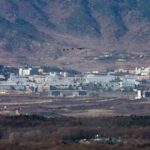
In response to North Korea’s mounting nuclear and missile threats, including recent fortifications along the Military Demarcation Line, South Korea’s Air Force conducted a live-fire test of the Taurus long-range air-to-ground missile. This test, the first in seven years, enhances South Korea’s ability to target potential provocation sites precisely. Conducted on October 8 and 10 over the West Sea, the missile, launched from an F-15K fighter, traveled approximately 250 miles before striking its designated target. To ensure safety, inert rounds without explosives were used.
The Taurus missile is a critical asset in South Korea’s arsenal. It is specifically designed to strike key North Korean targets from beyond the reach of their air defenses. The missile can evade North Korean radar systems thanks to its stealth capabilities, allowing pilots to execute precise strikes while remaining outside enemy air defense zones. This feature significantly enhances the survivability of both the pilots and their aircraft in hostile scenarios.
Equipped with military-grade GPS, the Taurus missile can achieve pinpoint accuracy within a 10-foot radius, even under jamming conditions. Known formally as a ‘Kinetic Energy Penetration & Destroyer’ (KEPD), the missile is engineered to penetrate up to 10 feet of reinforced concrete, making it especially effective for targeting underground bunkers. Its maximum range extends to approximately 310 miles, allowing it to reach key facilities deep within North Korea.
With a top speed of 722 mph, the Taurus missile can strike targets across North Korea within minutes. It can reach strategic sites within 15 minutes when launched from near Seoul. Similarly, if deployed from Daegu’s 11th Fighter Wing, the missile could hit critical facilities in Pyongyang within 20 minutes, underscoring its rapid response capabilities.
The Taurus missile was first operationally deployed in 2016, with around 260 units entering service. A live-fire exercise followed North Korea’s sixth nuclear test in September 2017. However, further live-fire drills were subsequently suspended to manage inter-Korean relations. This recent test marks a renewed commitment to ensuring operational readiness.
Captain Jo Myung Soo of the 11th Fighter Wing, which conducted the exercise, emphasized the strategic value of each Taurus missile. “Each Taurus missile is a high-value asset for our military,” he stated. “I will share this experience with all F-15K pilots to build our expertise in deploying these weapons.”

Named after the Greek word for ‘bull,’ the Taurus missile reflects its robust and powerful design. Measuring 16.7 feet and weighing 3,086 pounds, it achieves a circular error probability (CEP) of 10 feet, ensuring high precision over a range of 310 miles. This level of accuracy allows the Taurus to strike within a narrow margin of error, making it ideal for high-stakes targeting missions.
Each Taurus missile costs approximately $750,000; when integration costs are included, the price reaches around $1.5 million. This makes it a significant investment within South Korea’s ‘Kill Chain’ strategy, which is designed to detect, track, and eliminate North Korea’s nuclear and missile assets. The Taurus made its Asian debut with the South Korean Air Force, adding a powerful asset to its arsenal.
Flying at nearly Mach 0.9 at low altitudes, the Taurus is designed to evade enemy air defenses. The missile can climb rapidly as it approaches its target to deliver a powerful kinetic strike from above, maximizing its destructive impact on fortified targets.
The Taurus employs a unique “delay fuse” technology, allowing it to penetrate deeper than most air-launched weapons. This makes it particularly effective against underground bunkers. Its dual-stage warhead system, featuring a pre-charge and penetrator, is optimized for destroying heavily fortified structures.
The Taurus has a sophisticated navigation suite comprising GPS, terrain reference navigation (TRN), and infrared imaging-based navigation (IBN). According to its German Taurus Systems (TSG) manufacturer, this “triple navigation system” allows the missile to overcome jamming attempts by seamlessly switching between navigation methods, ensuring it reaches its target precisely, even under adverse conditions.


South Korea’s first indigenous fighter jet, the KF-21 Boramae, is set to be equipped with advanced weaponry, including supersonic anti-ship missiles and long-range air-to-ground missiles. The latter is particularly vital to bolster its strike range. South Korea is exploring collaborations with foreign tech to expedite development and enhance reliability, evaluating options such as the GBU-31 JDAM and locally developed precision-guided bombs (KGGB). The Air Force’s recent deployment of the upgraded Taurus K-2 missile highlights this joint development approach, with German Taurus Systems and South Korean defense firm LIG Nex1 working together on the project.
The Taurus K-2, a more compact and lightweight evolution of the original Taurus missile, extends its operational range beyond 372 miles—outperforming the original model’s 310 miles. This upgrade enables the missile to be integrated not only on the KF-21 but also on the FA-50 light attack aircraft, enhancing its versatility and operational reach.
German Taurus Systems has openly offered to support system integration for the KF-21 and KF-16 jets, intending to broaden South Korea’s deployment options for the Taurus KEPD 350K. Speaking to South Korean media, the company’s CEO emphasized the strategic advantage of equipping multiple aircraft models with the Taurus, easing the burden on F-15K fighters currently carrying these missiles.
With over 260 Taurus 350K units, South Korea’s Air Force is the only Asian military equipped with this formidable missile, which is currently mounted exclusively on F-15K fighters. These jets carry out crucial missions, including possible preemptive strikes against high-value targets in North Korea.
Given the scheduled performance upgrades for the F-15K fleet, the Air Force may face temporary capability gaps in its long-range strike arsenal. Deploying the Taurus 350K on the KF-21 and KF-16 platforms could provide essential backup, ensuring South Korea maintains consistent strike capability and readiness even as the F-15Ks undergo enhancements.















Most Commented